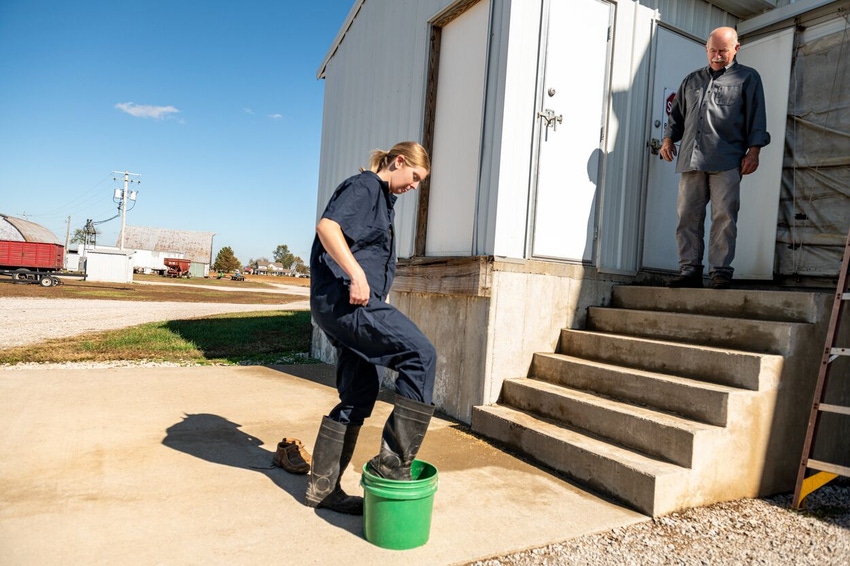Biosecurity is center of best farrow to finish performance
Now is the time to take a deep dive into biosecurity on your farms to protect the health, performance of your sows and growing pigs.
February 20, 2024

By Laura Dalquist, DVM, Swine Vet Center
As an industry, we understand well the cost of disease breaks like porcine reproductive and respiratory syndrome ($250 - $1000 per sow including downstream impact), porcine epidemic diarrhea (4-5 weeks of total piglet mortality) and Mycoplasma hyopneumoniae ($4.50 - $12 per pig depending on stability). With the economic pressures of the last 18 months, it has been imperative to protect not only the health of our sows but also the pigs leaving the sow farm. It’s not only important to keep growing pigs healthy for their performance, but also to lessen the geographical disease pressures these contaminated growing pig sites place on sow farms. Consequently, developing a solid biosecurity culture is critical to protecting the health of your sow farms and achieving excellent grow-finish performance.
Starts with clear protocols for all farm contact
It is important to ensure biosecurity protocols are understood by everyone involved in the process. Considerations when writing protocols include: the shorter and more concise, the more likely they are to be read and followed, pictures help to demonstrate procedures and protocols should be written in the language(s) of the farm staff. Biosecurity procedures that are implemented on-farm can be different in how they are performed but the principles remain the same.
To be successful, multiple layers of protection (James Reason’s Swiss Cheese Model) should exist between the pigs and the outside. Protocols must be developed and taught for critical areas including farm entry, mortality removal, pig loadout, supply entry and the handling of emergency repair and maintenance. Emphasis must also be given to biocontainment practices; biosecurity procedures for items or people leaving a site should mirror entry protocols to prevent tracking infectious diseases off a farm. There is often a delay from pathogen entry to disease diagnosis on a farm, during this time it is easy to spread disease unintentionally.
Farms that are successful in their biosecurity programs continuously look to improve procedures, advance compliance and add resources to reduce direct contact between the inside and outside of the barn. Biosecurity improvements don’t always have to come with a large price tag to be effective. An example of this is adding a bench, clothing change area and sink for washing hands to a finishing barn, which provides a physical separation and sanitation step before entering the pig space. Another common example is the use of dry disinfectants during cold weather to decontaminate loading chutes that cannot be washed during the winter months. We should always be looking for ways to improve our current biosecurity without making the process more cumbersome.

Swine Vet Center
Training, awareness and auditing the process
The best protocols don’t mean much without good execution every day. We shouldn’t expect that biosecurity procedures will be followed without a training program in place. It is important that each person responsible for execution of a task not only understands the appropriate steps and the order of these steps, but also why they are being asked to follow a specific procedure. Reviewing known disease pressure around the farm as well as the cost of a break to the farm speaks volumes on the importance of biosecurity. Using information from the Morrison Swine Health Monitoring Project and Swine Disease Reporting System, it’s never been easier to understand disease pressure outside the farm.
Just as clear and timely training programs help ensure the protocols are understood, audits of the processes will confirm these protocols are executed properly. Farm visits by people who don’t work on the farm daily (veterinarians, supervisors, biosecurity officers, etc.) are excellent opportunities to audit these processes but may not be frequent enough to catch and correct costly mistakes. Creating a simple checklist and assigning more frequent audit responsibilities to someone on the farm provides a consistent measurement of all processes on a more regular basis; weekly or every other week audit routines of each critical area of the farm have been helpful to identify and close gaps quickly. Video or electronic verification of some processes (chute procedures and time and temperature validation in supply entry rooms) have also been great additions to the auditing process.
Disease break investigations
When a new disease is confirmed on a farm, there has been value in taking time to understand how the pathogen may have entered to prevent the next one. A critical first step to detailed information sharing with caretakers is to emphasize that this is a learning opportunity for all of us to be better and to plug any gaps that we may have. Many investigations do not pinpoint the exact cause of the break, but it is still important to ask the questions. Commonly, biosecurity opportunities are found that result in improvements made as part of a disease break investigation.
Summary
Now is an excellent time to take a deep dive into biosecurity on your farms to tighten any gaps and protect the health and performance of your sows and growing pigs. Even small, low-investment improvements in the right areas can have a big impact on your bottom line. Your veterinarian and other biosecurity experts in the industry would love to help you prevent the next health challenge on your farm and fully capitalize on better hog prices!
You May Also Like



